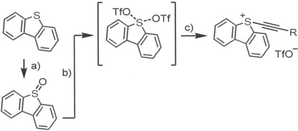New class of Reagents for Alkynylation and Cyanation
Scientists from the University of Göttingen developed novel reagents to attach terminal C-C or C-N triple bonds to organic molecules. These novel, sulfur based reagents have two striking advantages over the widely used EBX based reagents: They do not suffer from being potentially explosive but still show high alkynylation rates with yields up to 90% and the reduced reactivity allows for selection of alkynylation sites in one molecule.
Challenge
The chemical versatility of the carbon-carbon triple bond is of high importance for the synthesis of fine chemicals. Therefore, reagents to facilitate alkynylation (the introduction of a carbon-carbon triple bond) are highly desirable, not only for industrial chemistry but also for biological and medical applications.
The first alkynylation-reagent described in literature was based on ethynylbenziodoxolone (EBX) and could be used for gold-catalyzed alkynylation of indoles, pyrroles, thiophenes, and furans. But there is an inherent drawback of EBX-based reagents, they are potentially explosive. An enormous effort was undertaken in industry and science, to reduce their tendency to explode. This lead to safer alkynylation reagents, but this came along with a reduction of the alkynylation yields. Thus, especially for industrial purposes there is a strong need for safe and efficient alkynylation reagents.
The inventors accepted the challenge and developed 5-(Akynyl)benzolthiophenium triflates, which fill this gap.
Our Solution
The inventors used transition-metal catalysis to perform electrophilic alkynylations, using the backbone of the Umemoto reagent (a dibenzothiophene). They developed a new class of alkynylation reagents, the 5-(alkynyl)dibenzothiophenium triflates, which can be synthesized with high efficiency (Figure1).

Figure 1) Synthesis of 5-(Akynyl)benzolthiophenium triflates:
(a) TfOH, H2O2, (1:2 equivalents), 0-->50°C, for 1h --> 47% yield. (b) Tf2O (1 equivalents), 50°, 1h --> not isolated. (c) TMS alkyne (1equiv.) --> R = Ph: 87%, R = p-(CF3)Ph 97%, R = TIPS 70%.
In contrast to EBX-based reagents, they do not have the inherent tendency to explode, show an improved chemoselectivity for thiols and they can transfer alkyne groups to Amides.
Advantages
- very good alkynylation efficiency
- intramolecular selection of alkynylation sites is possible
- in contrast to EBX-based reagents there is no inherent tendency to explode
- broad substrate scope and high functional group tolerance
- easy synthesis
- cost effective production as a result of easy synthesis and no tendency to explode
These properties of 5-(Akynyl)benzolthiophenium triflates makes them a n in many cases superior alternative to the currently preferred EBX-alkynylation reagents.
Applications
Terminal alkynes, are valuable in the synthesis of of fine chemicals in industry as well as for scientific and medical applications. As a result of not beeing explosive, the synthesis of these alkynylation reagents can be upscaled. Reagents to attach alkyne-groups to chemicals are needed as basis for complex synthesis and could be used universally. The increased selectivity allows for selective transfer of alkyne-groups, even in makromolecules.
Development Status
The superior properties of lead compounds from this class of Reagents are proven experimentally in laboratory scale.
Patent Status
A US patent is granted and a DE patent application is filed in the name of Georg-August-Universität Göttingen public law foundation.
Referenzen
Publication Waldecker et al. (https://doi.org/10.1002/anie.201807418)
Homepage of Prof. Alcarazo: (https://www.uni-goettingen.de/de/forschung/569682.html)
Contact
Dr. Vanessa Jensen
Patentmanager Life Sciences
E-Mail: This email address is being protected from spambots. You need JavaScript enabled to view it.
Tel: +49 551 30724 149
Reference: BioT-2116-SUG
Tags: New compounds
